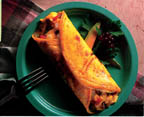
Creating coatings involves a delicate balance of ingredients on various substrates. Eggs, starches, gums, flours, and leavenings help with adhesion on substrates such as chicken, fish, vegetables, or cheese.
Coating Creations
Food products can be battered, or battered and breaded. Coatings are specified depending on the substrate that is being coated. Formulation variables include cooking methods such as frying, oven-baking, or microwaving, as well as moisture level, temperature and surface characteristics of the substrate. Processing variables such as line speed and location, as well as water quality, set-up time and breading pick-up all play a role in coating quality and adhesion.Batters are composed of flour and other components such as starches, milk, eggs, seasonings, leavenings, and stabilizers. Batters can be specified according to degree of adhesion (high or regular). Adhesion batters are used as an undercoat before applying the breading—they generally are high in adhesion starch. These undercoatings serve as a cohesive layer between the substrate and the breading, acting as the glue that holds the breading to the substrate. Adhesion batters prevent surface voids through the loss of breadings. They also reduce crumb fall-off, which extends the life of fryer oil. The viscosity or thickness of these batters can be adjusted to give the desired pickup.
Tempura batters are stand-alone systems that are not further breaded. They provide a protective outer coating which can range in texture from crispy and crunchy to cake-like. Tempura or puff batters produce a smooth, crisp, light coating. They can be formulated to minimize oil pick-up and—generally—contain flour and a leavening system that allows the coating to puff when exposed to frying oil.
A pre-dust often is used to maximize adhesion between the substrate and the subsequent coating. It generally consists of crackermeal, fine breadcrumbs, or straight flour. The particle size of pre-dusts is usually fine, for maximum adhesion.
“A high adhesion pre-dust consists of fine crackermeal that may have flavoring agents added to it,” says Susan Petersen, senior scientist for a coatings supplier. “High adhesion pre-dusts may include powdered eggs and starches to optimize the substrate coating. The pre-dust enhances the batter's ability to cling.”
Pre-dusts help with adhesion, especially in the case of frozen fish. “The surface of fish is much like that of an ice cube,” says Ken Rowe, director of sales for a coatings supplier. “It is very slippery and difficult to adhere to. Tempuras do a poor job of adhering to proteins. You can't get a tempura to stick to chicken or fish all by itself. It just slides off, so you need to prepare the surface by using a pre-dust coating.”
Crackermeal breaders are common in the industry. Other types include American-style breadcrumbs and Japanese-style breadcrumbs (a.k.a. panko). J-crumbs, popular in coated shrimp, are more porous and produce a crispy outer coating. Various crumbs can be blended together depending on the desired texture.
The pick-up of a coating, or the amount that adheres to the surface, varies according to the type of coating. Generally, pick-up rates are as follows: 5-7% for a pre-dust, 15-18% for a batter, and 10-12% for a breading. The total pick-up can vary between “20-60%”, in general. Products for retail (generally oven-cooked) are coated more heavily than products for foodservice (usually fried). For example, retail fish products average between 40-60% coating, while foodservice items average about 25-35% coating, says Rowe.
Some items demand more coating. For popcorn shrimp, the total pick-up can be around 50%. Small count shrimp are coated heavily with a pre-dust, batter, and breader.
Blending Ingredients
Ingredients that help with batter adhesion include flour, starches, hydrocolloids, proteins and leavening systems.
Flour. Wheat flour is the main component of most batters and breadings. Flours contribute to viscosity and promote adhesion by forming a glutinous network that provides structure. A dry batter mix generally contains between “80-90%” flour. Other flours such as rice, corn, soy, or potato may be added for special effects.
Starches. Starches help with crispness, batter adhesion, and moisture control. Traditionally, starches have been used for adhesion purposes. Starches with higher amylose content are better film formers. High amylose starches also help reduce fat pick-up. While modified corn starches are used most often, others used include potato, wheat, and tapioca. Combinations of different starches affect the texture. Modified starches can add freeze/thaw stability to a par-fried product that is fried and then frozen. Starch levels of 5-30% of the dry mixture are common.
Production line speed is a factor as to proportion of ingredients such as starch. With high line speeds, high starch undercoatings are necessary, says Rowe. However, in a small plant that has low line speeds, a lower starch level is needed to avoid setting the coating too quickly, preventing the breading from sticking to it, he adds.

Xanthan gum is cold water-soluble and builds batter viscosity. In the plant, it helps with pumpability of batter. Xanthan will provide cling to the batter to help it adhere and prevent it from falling off.
“Hydrocolloids help the coating adhere before it reaches the cooker so there is more consistent distribution of the coating around the product,” says Mark Hines, Ph.D., manager of sales and technical service for a hydrocolloids supplier. “Xanthan will produce almost instant viscosity when using a fine mesh size—200 mesh.” Typical use levels for xanthan range from “0.1-0.15%” on a wet basis.
Methylcellulose (MC) can be used in batters to keep the substrate moist. Because of its ability to gel at high temperatures, MC creates a barrier that prevents moisture from migrating out too rapidly. Less fat migrates into the product during frying with this barrier.
“Both xanthan and MC help with batter adhesion—xanthan does it by building viscosity, while MC does it through gelation,” says Hines.

Leavening. The gas release characteristics of the leavening system affect the texture. Timing of the release affects coating adhesion. Generally, baking soda and various phosphates are used as leavening agents in tempura batters.
When excess moisture and/or gas escapes through a batter, undesirable holes are produced, and referred to as “blowout.”
“The leavening agents help with adhesion by allowing the substrate to breathe,” says Petersen. “Blowout occurs when there is no leavening in a batter fry. Or, if the leavening system isn't balanced correctly one part reacts before the other, causing blowout.”
Building Better Batters
No matter how good your coating system formulation, problems may occur. If the coating falls off, formulators need to know exactly what happened and when.“Telling your supplier that the coating simply did not stick gives us no useful information—we usually need to see the product run in the plant in order to determine what formulation and/or processing adjustments are necessary—whether the line is too slow, the batter too thick, etc.,” says Rowe.
Pilot plant tests generally are run to test the coating before production is scaled up. “One of the most important considerations in the coatings industry is to have an R&D line that actually duplicates the real line,” says Rowe. Pilot plant tests are critical to success and overall cost savings.
Sidebar: Gums and Stabilizers
Stabilizers that work in diverse products are available under the Michtext brand. Applications include low- and no-fat desserts, dairy products, and meats; also, salad dressings, sorbets, bakery products, beverages and many other foods. David Michael & Co. also offers stabilizers and natural flavor systems under the Michaelitet brand, designed specifically for low- and no-fat applications. David Michael & Co., Steve Wilbur, 800-DM-FLAVORSThese emulsifiers are functional ingredients providing stabilization in dairy or substitute dairy systems. Dur-Em (mono and diglycerides), Durlac (lactylated monoglycerides) and Durfax (polysorbates) control emulsion stability, viscosity, plasticity, freeze-thaw stability and overrun in frozen desserts, dressings, dips, toppings, puddings, coffee whiteners and imitation cheeses. Loders Croklaan, Ed McIntosh, 800-621-4710
This locust bean gum's milk reactivity and distinctive viscosity characteristics make it a top choice for sauces, soups, and processed cheese applications. TIC Gums' TICorganic™ Locust Bean Gum is a new addition to the TICorganic line of certified organic gums. In ice cream, it is used to slow the rate of melt-down and improve storage properties; in bakery products, it helps to retard staleness. For free samples call 800-899-3953 or visit www.ticgums.com. TIC Gums, Frances Bowman, 800-221-3953, info@ticgums.com

The Vitex ADM series for aerated yogurts provides viscosity for whipping, product firmness and stable foam structure. In addition, the stabilizer blend enables an overrun range between 50-100%. Also new from Degussa Texturant Systems is the Vitex ABA series for improved buttermilk. Degussa Texturant Systems, 800-241-9485, www.texturantsystems.com
Did you know that eggs could perform more than twenty distinct functions in the development and processing of food? In fact, eggs perform multiple functions in food formulations while simplifying the ingredient statement. Visit www.aeb.org to learn the latest information on egg products, specifications, and functions as well as locate a supplier of processed egg products to meet your specific needs. Got a technical egg question? Call the American Egg Board, Dr. Glenn Froning, Egg Answer Hotline, 877-488-6143
A global leader in the hydrocolloids market, CP Kelco offers a broad range of gums and stabilizers to the world's processed food industry. Their products include KELTROLt xanthan gums, KELCOGELt gellan gums, and the GENUt ranges of pectin and carrageenan. CP Kelco, Cindy Palermo, 858-292-4900, solutions@cpkelco.com
This modified food starch has been designed to be stable in foods that have high-acid formulations, and either high-shear and or high-temperature processes. Like all PURE-GELt starches from Grain Processing Corporation, PURE-GELtB994 also has excellent freeze/thaw stability. Contact the company for a sample and answers to all your technical questions. Grain Processing Corporation, Diane Rieke, 563-264-4230, www.grainprocessing.com
A manufacturer of custom-designed stabilizers, texture systems, and flavor and seasoning systems, Advanced Food Systems has been doing business for more than 20 years. The company's expertise in problem-solving and creating new products with fast turnaround times is available to customers in the processed meat and poultry, dressings and sauces, frozen foods, snacks, and bakery industries. Advanced Food Systems Inc., 732-873-6776